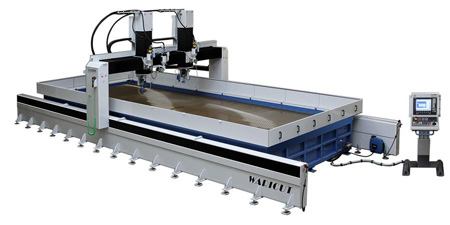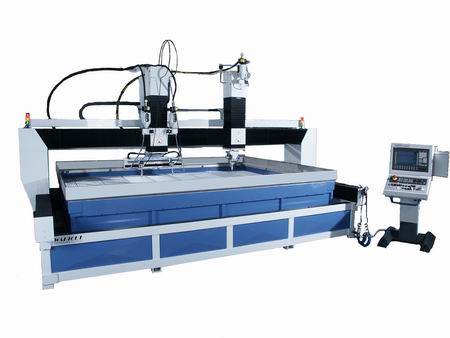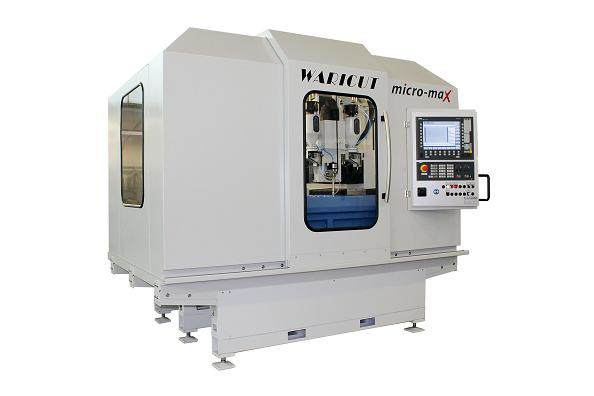The waterjet cutting processes Microwaterjet and Waterjet offer interesting possibilities to cut different materials and substances with the help of a water jet. It is a future-oriented and also environmentally friendly technology, which enables a high degree of automation in cutting a wide range of materials. The technology was already developed in its basic features at the beginning of the 20th century. In this original process, a high-pressure water jet was already being used to extract coal and ore in mines. A few decades later, the process was refined and the first water jet cutting machines for industrial use for cutting workpieces of different materials were produced. In the meantime, even stronger materials can be cut with this technology easily and above all very precisely.
How waterjet cutting works
In principle, the process is quite simple: The material to be processed or separated is separated by a water jet at an extremely high pressure. A water pressure of up to several thousand bar can thus be created on the surface of the workpiece. The speed at which the water jet emerges reaches values of up to 1000 meters per second, whereby the material to be cut hardly heats up at all, which is one of the main advantages of this process. For this reason, waterjet cutting can also be used for processing hardened steel. Of course, the water quality must be high and meet certain requirements. A basic distinction is made between cutting with pure water and so-called abrasive cutting, a technology in which a powdery material is added to the water. Pure water is usually used to cut somewhat softer materials such as plastics, foils, textiles, fibers, elastomers or even foams. Additional materials added to the water jet are used when harder materials such as metals, glass, ceramics and hard rocks are to be separated by cutting. The environmentally friendly method for cutting a wide variety of materials is also used particularly frequently for composite materials, which are usually not very easy or even impossible to cut with other, conventional methods. Frequently, a so-called micro-cutting process is also used, in which natural sand is added to the water jet in a special mixing chamber.
The advantages of this technology
One of the main advantages of the process is that cold separation of different materials is possible without additional heat influence. Expansions or distortions, which can occur with other heat-generating processes, are completely eliminated. Furthermore, extremely thin parting lines can be achieved, which allows an optimal use of the material. No deformations occur in the cutting area either. Multi-layer cutting is possible without any problems, and all materials can also be processed in sandwich construction. Narrow radii, complicated contours as well as extremely thin wall thicknesses can be realized without problems. This enables an extremely flexible production of the most different workpieces. The Microwaterjet and Waterjet processes work with highest precision. The error tolerances are in the range of only a few hundredths of a millimeter. Larger workpieces with an area of several square meters and a high material thickness can be processed without any problems. In the range of a lower cutting accuracy of about one tenth of a millimeter, waterjet cutting allows extremely fast and precise work. Many of the machines for the Microwaterjet and Waterjet cutting processes can operate in different modes, which usually differ in terms of processing quality. Due to the very low processing temperatures, no toxic fumes can be generated during the processing of various materials (e.g. plastics).
The micro waterjet cutting process
Besides the conventional cutting of different materials with a water jet, there is also the so-called micro water jet cutting process. This is a further refined process that works with a high-precision water jet. The jet diameter could be reduced by a factor of 5 compared to the other method. This new process enables a cutting accuracy of only one hundredth of a millimeter. The general advantages of cutting with a water jet remain the same. This extremely precise process results in an enormous variety of possible applications, which for a long time were not considered feasible.
Working with water jets
In addition to cutting workpieces or materials, water jetting can also be used for other applications such as final deburring and cleaning workpieces with water jets. This process is particularly suitable for cutting heat-sensitive materials that are processed. Very filigree and complex shapes can also be realized without problems. A further advantage of the process, which should not be underestimated, is that the cut can be made at any point on the workpiece. And even reflective surfaces, which are very difficult to process with other methods such as laser cutting, do not pose a problem with waterjet cutting. In principle, waterjet cutting is particularly popular where other processes (e.g. metal cutting processes) would lead to damage or even destruction of the materials.



